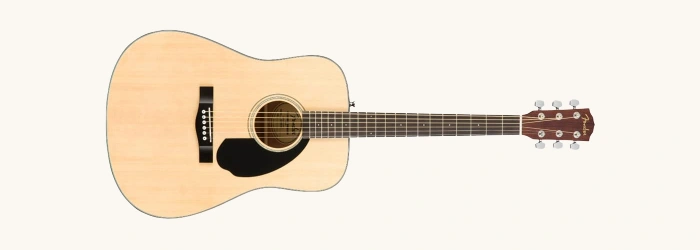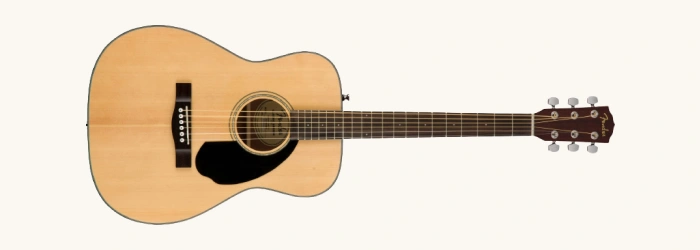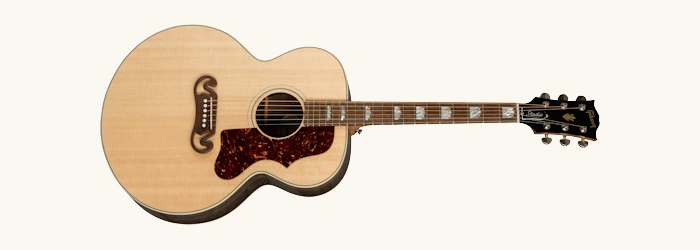There are different types of acoustic guitars and every type has a different shape, and size, and produces different kinds of sound.
Some guitars are great for strumming, some sound great when you play arpeggios, and so on.
If you are a beginner, it’s important to have a basic understanding of how they differ from each other and how they sound.
Types Of Acoustic Guitar Bodies
Acoustic guitar types vary by different features but the main differentiating thing is the body. And names of acoustic guitar types come from the body shape.
In this beginner guide, I will cover the main types of acoustic guitars and talk about various characteristics and sounds.
Dreadnought Acoustic Guitars

The dreadnought acoustic guitar is one of the most popular guitar body shapes in the world, known for its distinctively large size and bold sound.
Developed by the C.F. Martin & Company in the early 20th century, the dreadnought features a wide lower bout, broad shoulders, and a narrow waist, giving it a distinctive appearance.
This shape allows for a larger soundboard and resonant chamber, which contributes to the guitar’s characteristic sound. Also, it works and sounds great if you use acoustic guitar pickups.
This makes it an excellent choice for strumming, as it can produce a loud and clear sound even when played aggressively.
The dreadnought’s deep bass response also gives it a warm and full sound that complements a wide range of genres and playing styles.
In addition to its strong and resonant sound, the dreadnought also offers excellent projection and sustain. Its strong mid-range and high-end frequencies make it ideal for accompanying vocals, as it can cut through the mix without overpowering the singer.
Dreadnought is a great acoustic guitar to record and it can be used for many genres.
Parlor Acoustic Guitars

Parlor acoustic guitars are small-bodied guitars known for their comfortable playability and unique tone.
Originally popular in the late 19th and early 20th centuries, the parlor guitar has made a comeback in recent years due to its vintage sound and aesthetic.
It typically has a small body with a narrow waist and a lower bout that is smaller than a dreadnought guitar. This compact size makes it a great choice for fingerstyle-playing and traveling musicians.
The parlor guitar’s small size also contributes to its distinctive tone. Its smaller soundboard produces a more focused sound with less bass response, which gives it a bright and articulate sound.
It’s one of my favorite acoustic guitar types and is perfect for the old blues style. There are many acoustic-electric parlor guitars that can be used with an acoustic amp.
Concert Acoustic Guitars

The concert body shape is a popular type of acoustic guitar known for its balanced sound and comfortable playability.
It typically has a smaller body size than a dreadnought guitar, with a slightly wider waist and a smaller lower bout. This results in a guitar that is comfortable to hold and play.
Concert acoustic guitar is also versatile, making it suitable for a wide range of playing styles and genres.
The concert guitar’s balanced sound is one of its defining characteristics. Its smaller body size produces a more focused sound, with a balanced tonal range that is neither too bright nor too bass-heavy.
Notes and chords ring out clearly, with a sweet and articulate tone that is particularly well-suited to intricate fingerstyle playing.
Jumbo Acoustic Guitars

Jumbo acoustic guitars are large-bodied guitars with powerful sounds and bold tones. It typically has a deep body with a wide lower bout and broad shoulders, making it one of the largest guitar body shapes available.
The jumbo guitar’s large size can make it a bit unwieldy for some players, but its bold sound and deep bass response make it a favorite of many guitarists.
The jumbo-style guitar’s powerful sound is one of its defining characteristics. Its large body size produces a wide range of frequencies, with a strong bass response that can be felt in the chest.
I love playing rhythm parts on jumbo guitars with a guitar pick and the sound blends perfectly with dreadnought-style guitars.
Overall, the jumbo acoustic guitar is a great choice for those looking for a bold and powerful sound, particularly for those who play rhythm guitar or need a guitar that can produce a loud and full sound.
Which Type Of Acoustic Guitar Is Good For Recording
There is not a particular acoustic guitar type that is good for recording because all of them are.
The only difference is that each type of acoustic guitar is great for a particular style.
In my opinion, the dreadnought is the best overall acoustic guitar for recording. It can be used for any genre and you can record rhythm and lead parts.
Parlor-style guitars are amazing for fingerstyle and blues. They have a very distinctive sound which is lower in volume and mellow in tone.
Concert acoustic guitars are also a good choice to record with but I won’t use them as a main source of the sound. More like an accompanying instrument.
On the other hand, jumbo guitars are one of my favorite types of acoustic guitars to record with. Especially rhythm parts and works well if you pair it with a dreadnought guitar.
My favorite way to record acoustic guitar rhythm parts is with dreadnought and jumbo.
That’s when guitar panning comes in very handy. I just pan one guitar to the left and another to the right side and it sounds amazing.
Conclusion
These are the main types of acoustic guitars and each has its sound and characteristics. There are other types too but knowing these four types is enough for beginners. Each is great for the different playing styles and all of them work perfectly for recording.
